What would you do if someone gave you a box of ripe, delicious pomegranates? I don't know about you, but making this Pomegranate Wine recipe was on the top of my list! If you've never made wine before, it's a fun and rewarding hobby, which will allow you to make various wines, including this Blueberry Wine!
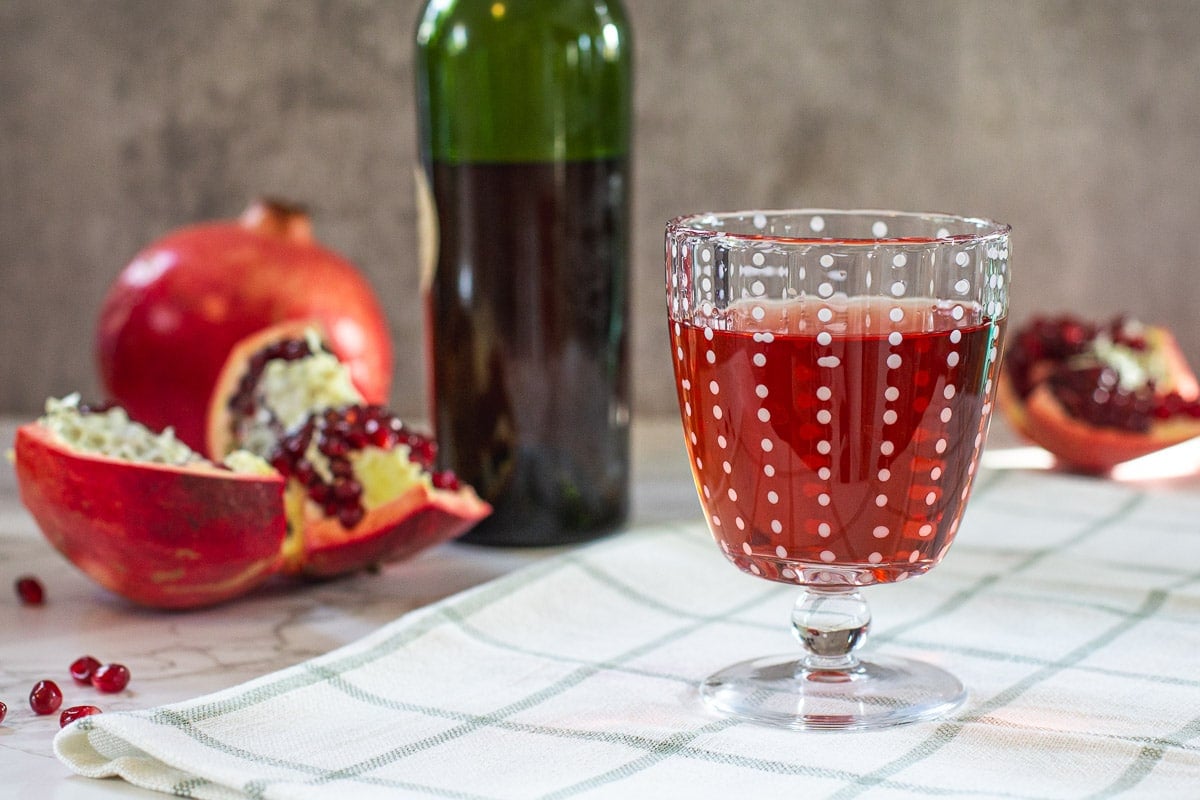
For as long as I can remember, I've always wished for a pomegranate tree. I didn't have enough room to grow one when I lived San Diego, and it's too cold to grow them in Montana. Cue the violins...
This is why I was stoked when my good friend, Leslie, sent me a box of the best pomegranates I've ever had. We all need a friend like Leslie, don't we?
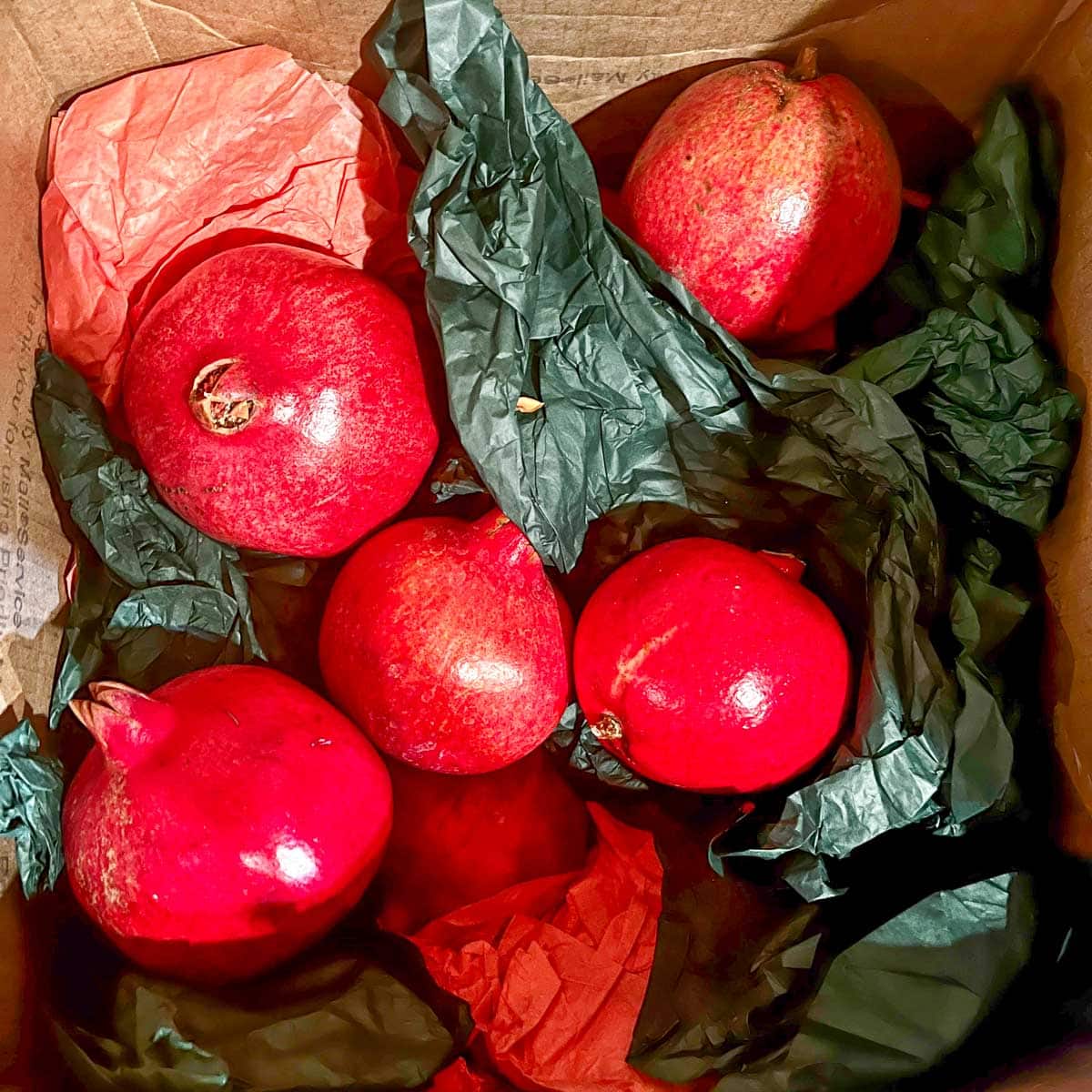
Since it's not too often that I have a box of pomegranates staring me in the face, I knew I had to take advantage of this opportunity and finally try creating this pomegranate wine recipe.
Pomegranate wine has its roots in the Middle East so it only seemed fitting that I try making it, and I'm so glad I did! Although it hasn't had time to age properly, it already tastes wonderful. It's light, fruity, and easy to drink. It also pairs well with a simple charcuterie board.
Jump to:
🧐 Why This Recipe works
- This pomegranate wine recipe is delicious and fairly easy to make, don't let this long post scare you!
- If you like slightly tart wine with a fruity taste, you'll love pomegranate wine!
- Six pomegranates will give you 5 bottles of wine, which is so much cheaper than purchasing 5 bottles of pomegranate wine.
- Homemade pomegranate wine makes a great gift for any wine lover.
- This pomegranate wine recipe makes a one gallon batch, which makes it manageable.
🛒 What You Need For This Recipe
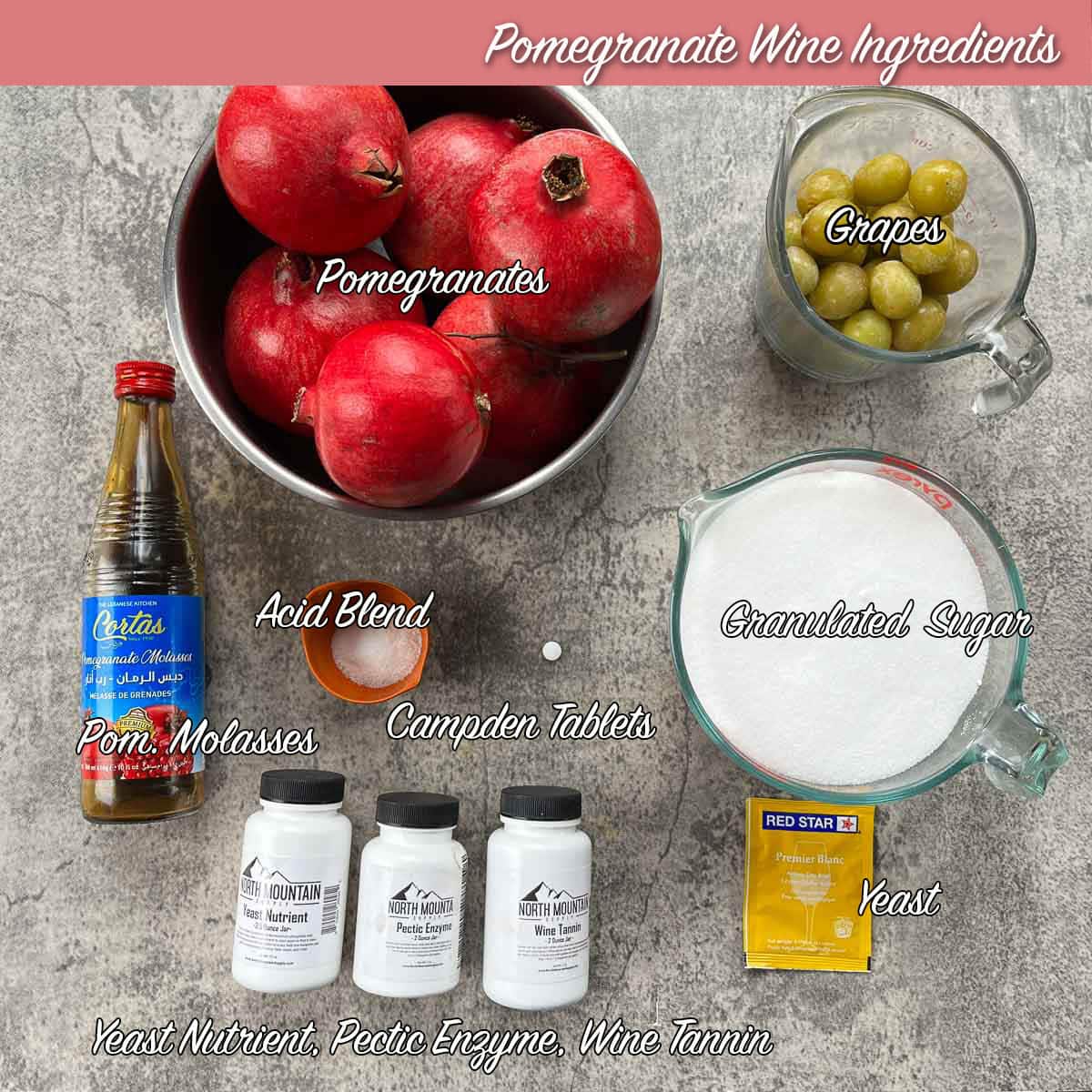
🔖 Recipe Ingredients & Substitutions
- Pomegranates: You will need 6 large pomegranates. Although some pomegranate recipes call for a gallon of pomegranate juice, my pomegranate wine recipe calls for fresh pomegranates. I will eventually try making pomegranate wine with Pom's pomegranate juice and update the results here.
- Grapes: I added 2 cups of frozen and blended white grapes because I didn't have white grape concentrate at home but you can definitely use that instead of fresh grapes.
- Sugar: You will need 2 pounds of granulated sugar = 4 cups.
- Wine Yeast: You can buy a variety pack to see what you like best. Some yeasts have higher alcohol tolerance than others. This means the finished wine has a higher alcohol content. You can find out more here. I used premier blanc for this recipe!
- Pectic Enzyme: Pectic enzyme is needed to break down the fruit into a pulp and also aids in extracting the tannins from the fruit.
- Yeast Nutrient: The yeast nutrient feeds the yeast so that it can remain healthy throughout fermentation.
- Acid Blend: Acid blend is a mixture of 40% citric, 40% malic, and 20% tartaric acid and is used to increase the acidity of the wine.
- Wine Tannin: Tannins improve the flavor of the wine.
- Campden Tablets: Campden tablets contain Sodium Metabisulfite and are used to keep wild yeast and bacteria from growing in your wine. It also helps to keep the wine from oxidizing, which will affect both the color and flavor of the wine. The tablets need to be crushed and dissolved into the wine.
- Optional: Although I did not add any spices, the next time I make pomegranate wine, I will probably add cardamom pods, cloves, or ¼ of a cinnamon stick.
🍾 Other Helpful Tools
- Sanitizer: All of your equipment needs to be sanitized every time you make wine. You have various options including a concentrated liquid sanitizer (Star San) or a powder that can be diluted in water (1-Step).
- 2 Gallon Plastic Fermenting Bucket: The primary fermentor is used for the first 5-7 days to get your fermentation/must going. Although it comes with a lid, I recommend covering it with a breathable fabric and securing it with a rubber band. The fabric keeps out the bacteria while allowing some oxygen in to help the yeast get started.
- Strainer/Mesh Bag: You can add your fruit to a mesh bag while it's fermenting or just dump everything inside the primary fermentor bucket. If you decide to use the bag, you'll squeeze the bag to extract the fruit juice and toss the solids that remain in the bag. If you decide to add the fruit directly inside the primary fermentor, you will need to strain the contents of the bucket before transferring it to a carboy.
- 1 Gallon Jug: You will need a one-gallon carboy, also called a demijohn, which is used for fermenting and clearing the wine. Having at least 2 is ideal, especially when racking or transferring the wine from one carboy to another.
- Mini Auto-Siphon & Tubing: The siphon and tubing are used when transferring the wine from one carboy into the next and also for bottling the wine. A bottling wand also comes in very handy but is not required.
- Air Lock and Bung: The airlock goes into the bung and the two together are used to cap the carboy when it is fermenting and clearing. The airlock keeps oxygen and bacteria from contaminating the wine while allowing the CO2 to escape.
- Hydrometer & Test Jar: A hydrometer is used to figure out the amount of alcohol your finished wine contains. This is done by taking readings of the specific gravity or SG at the beginning, during, and at the end of the fermentation process.
- Funnel: You'll need a funnel for straining the fruit, especially if you don't use a mesh bag. I like this funnel.
- Jug: A small creamer like this one comes in handy when taking SG readings.
- Bottles/Corks/Corker: Most people begin by bottling their wine in flip-top bottles. However, as they continue to make wine they usually end up purchasing wine bottles, corks, and a corker.
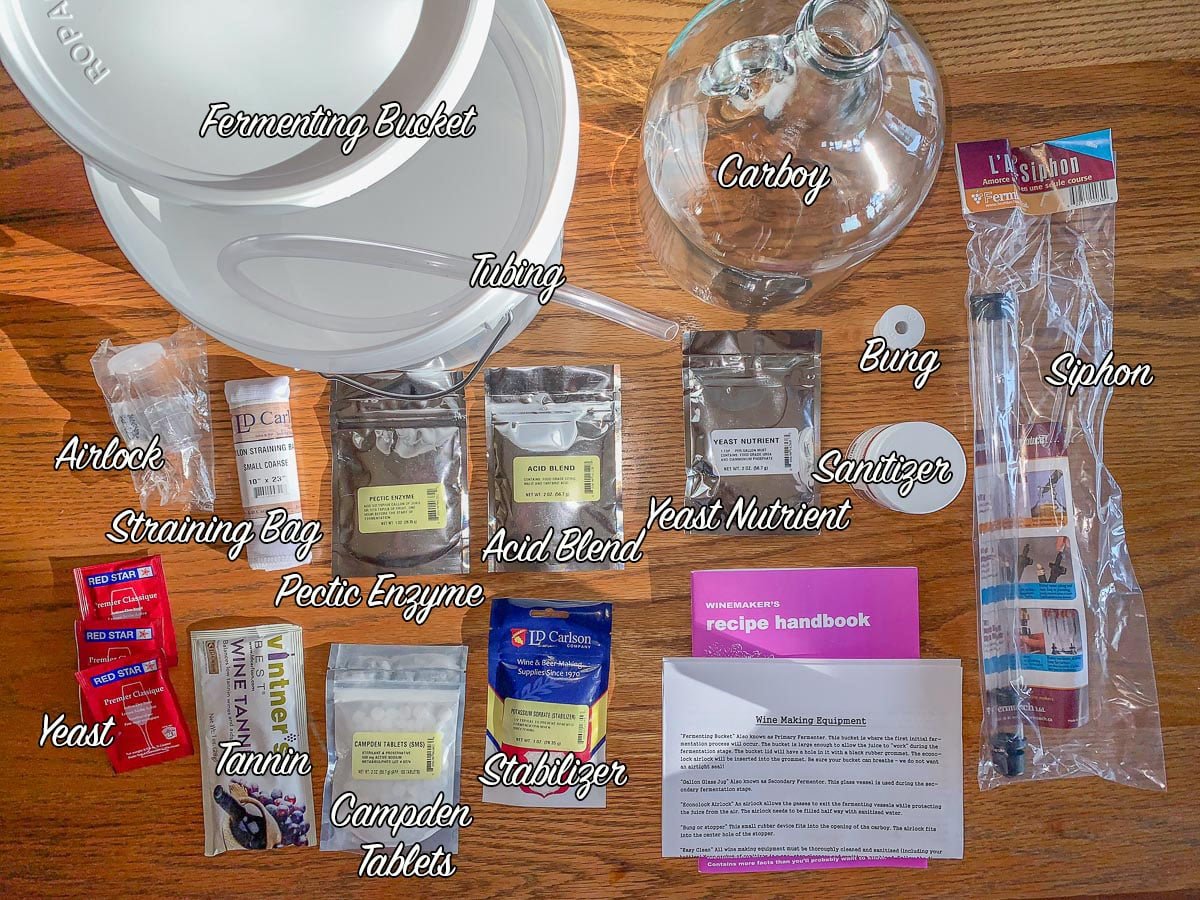
This wine making kit is the one I recommend because it has almost everything you need!
🍷 How to Make Pomegranate Wine
Day One
Before you start, you need to sanitize all of your equipment, your work area, and your hands. You can find out how here.
Step 1: Wash and peel pomegranates by removing both the peel and membranes between the aril (seeds). Mash the fruit using a potato masher or better yet, a ricer, to release the fruit juice. Do this over your fermenting bucket to catch every ounce of pomegranate juice.
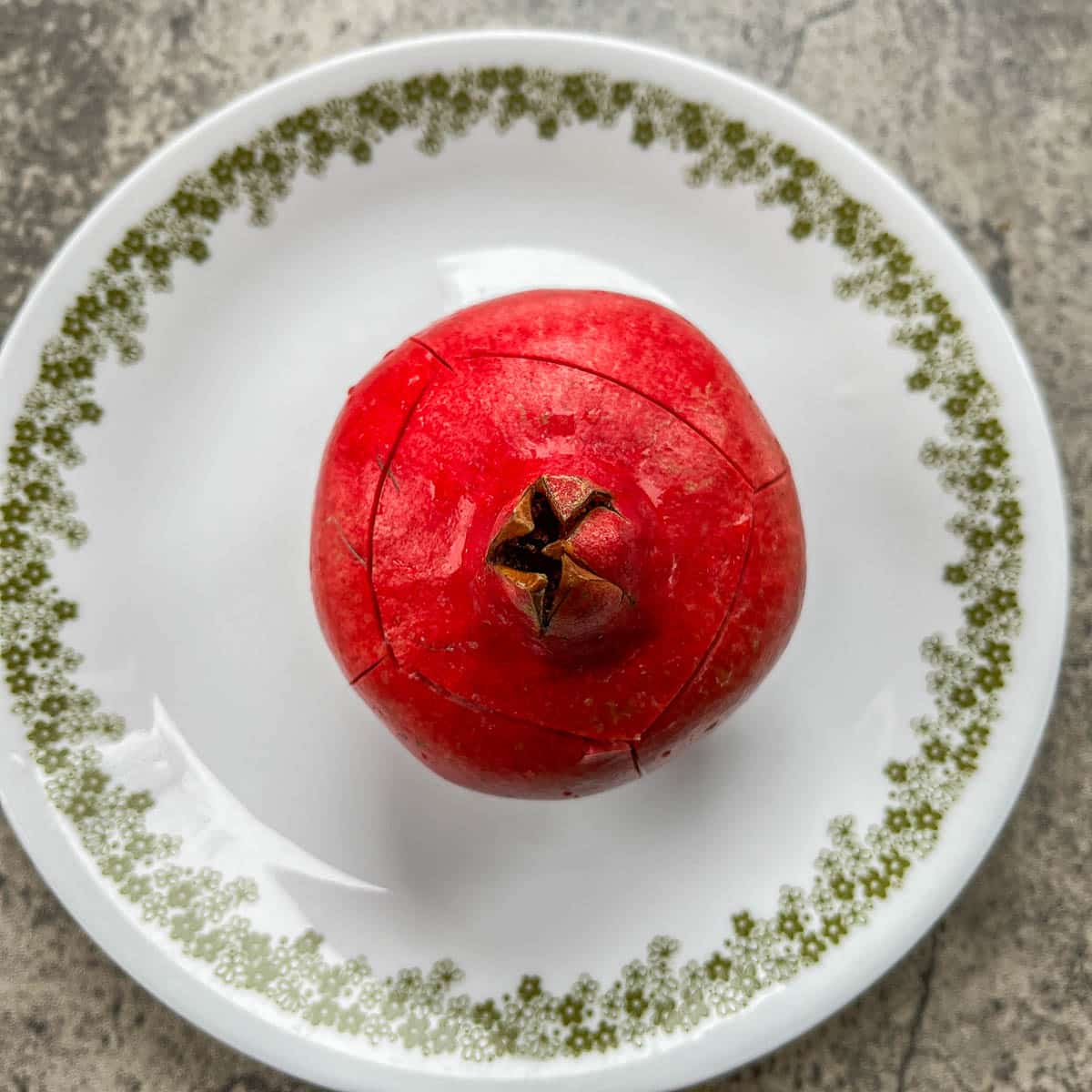
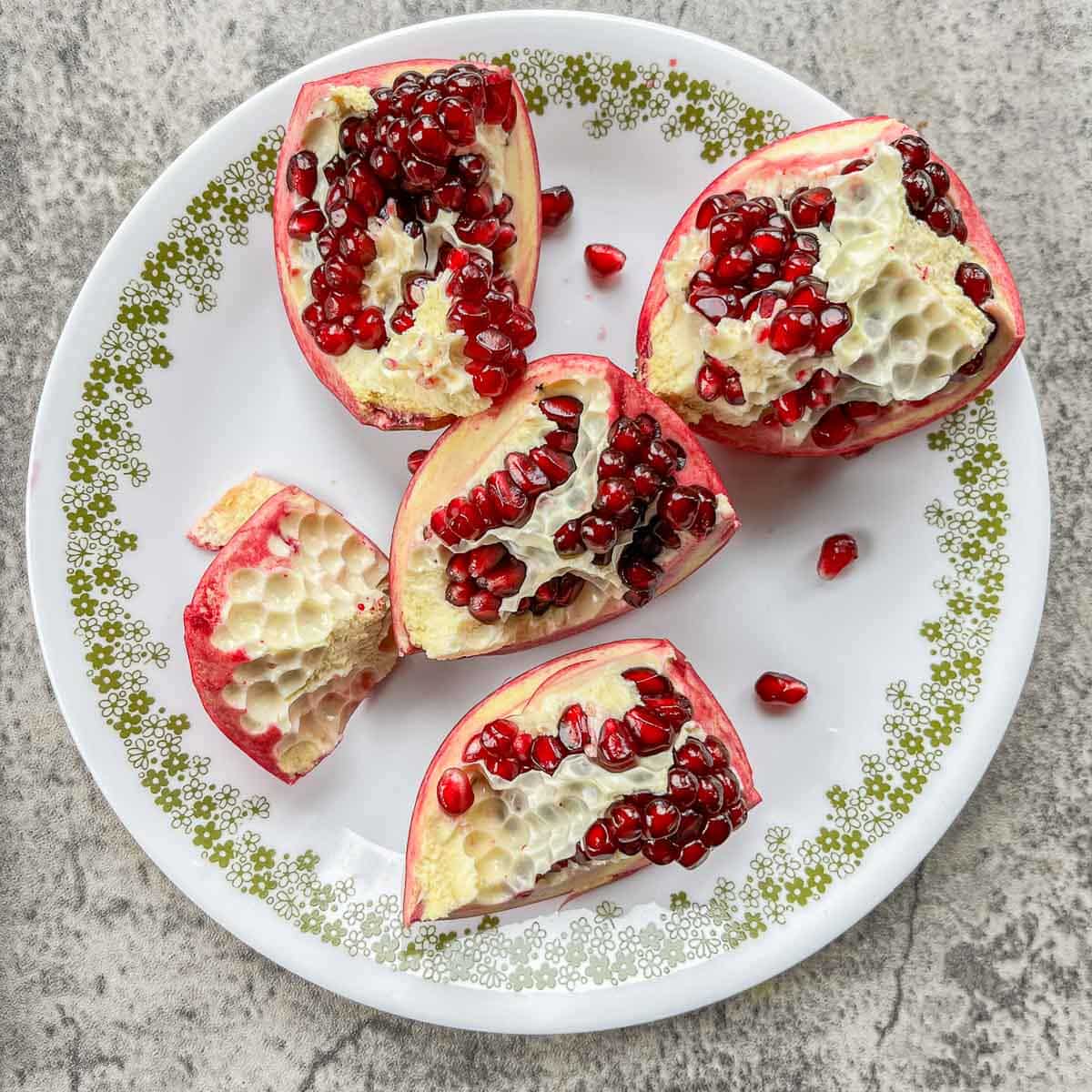
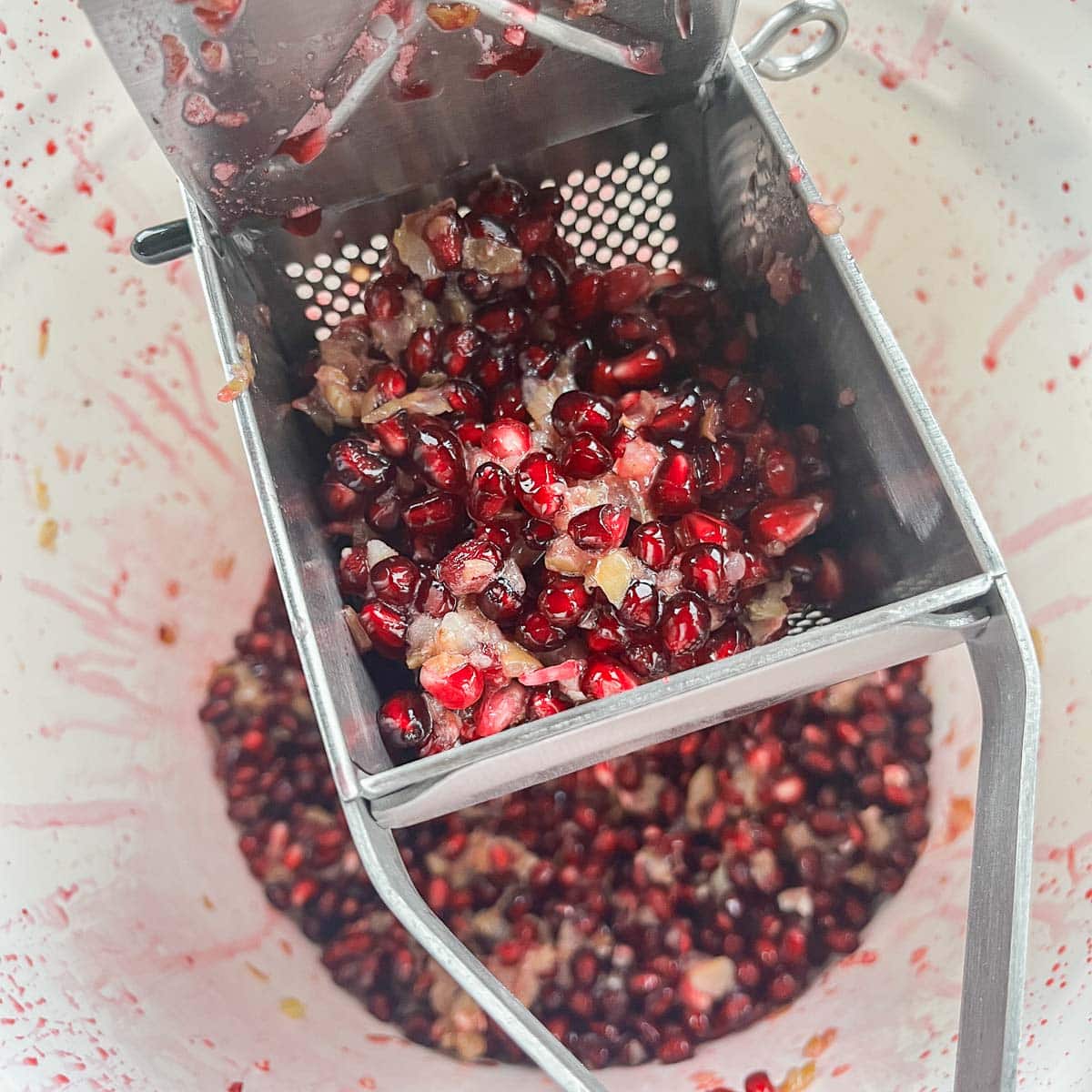
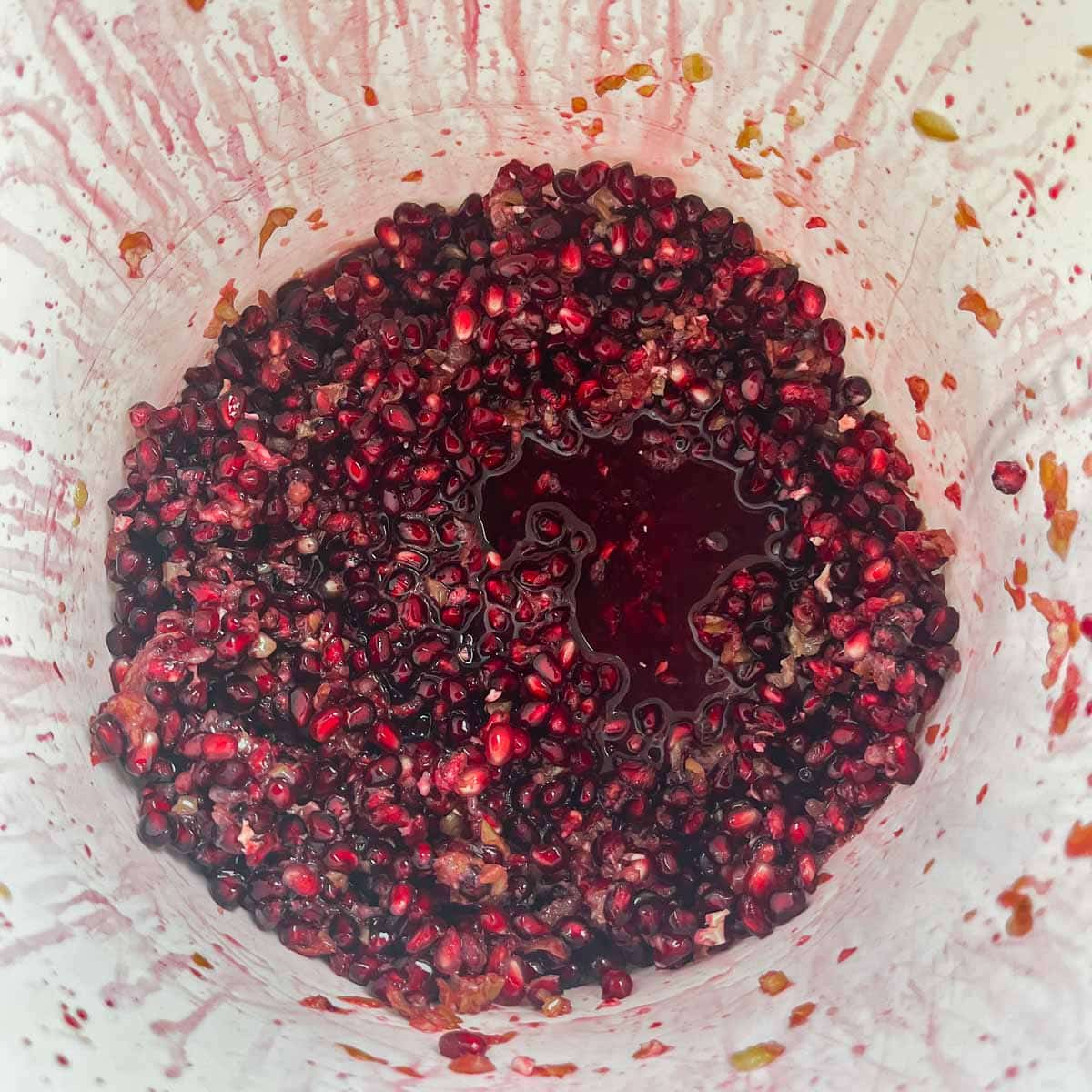
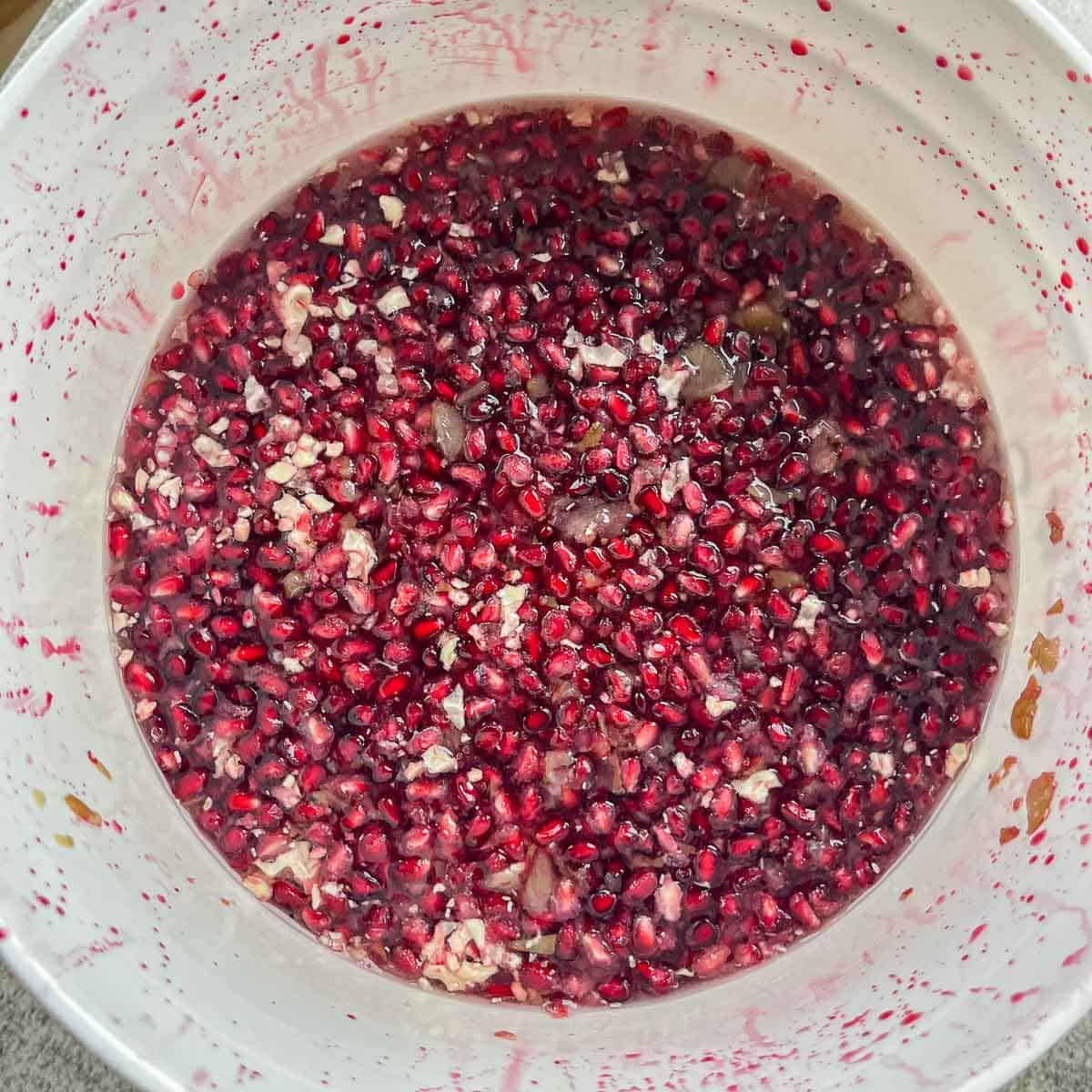
Step 2: Blend grapes in a food processor to extract their juice then add to the bucket.
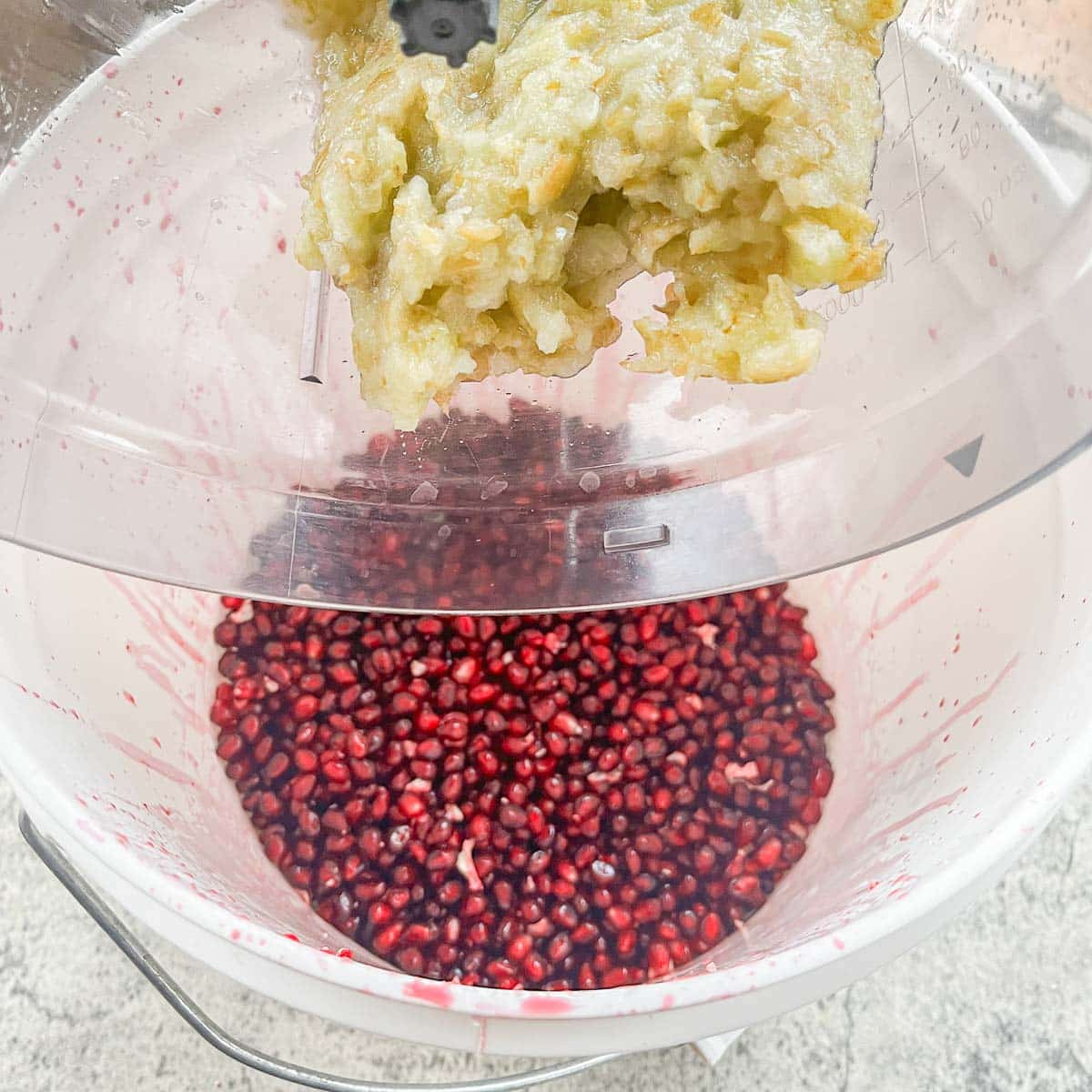
Step 3: Add sugar to a stock pot and cover with one gallon of water. Whisk sugar and water and simmer over low heat until sugar is dissolved and the syrup is hot, but not boiling. Pour sugar water over the mashed fruit.
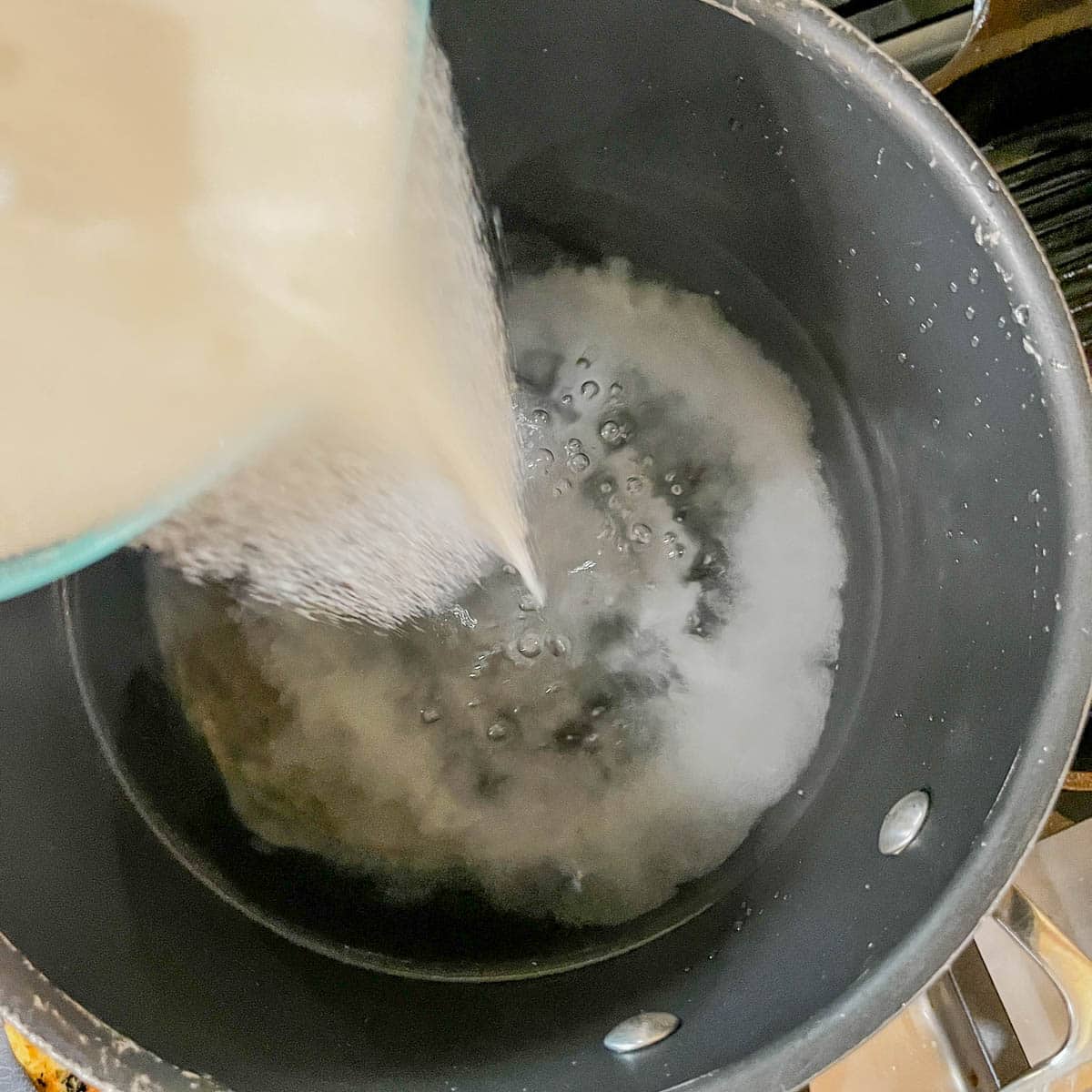
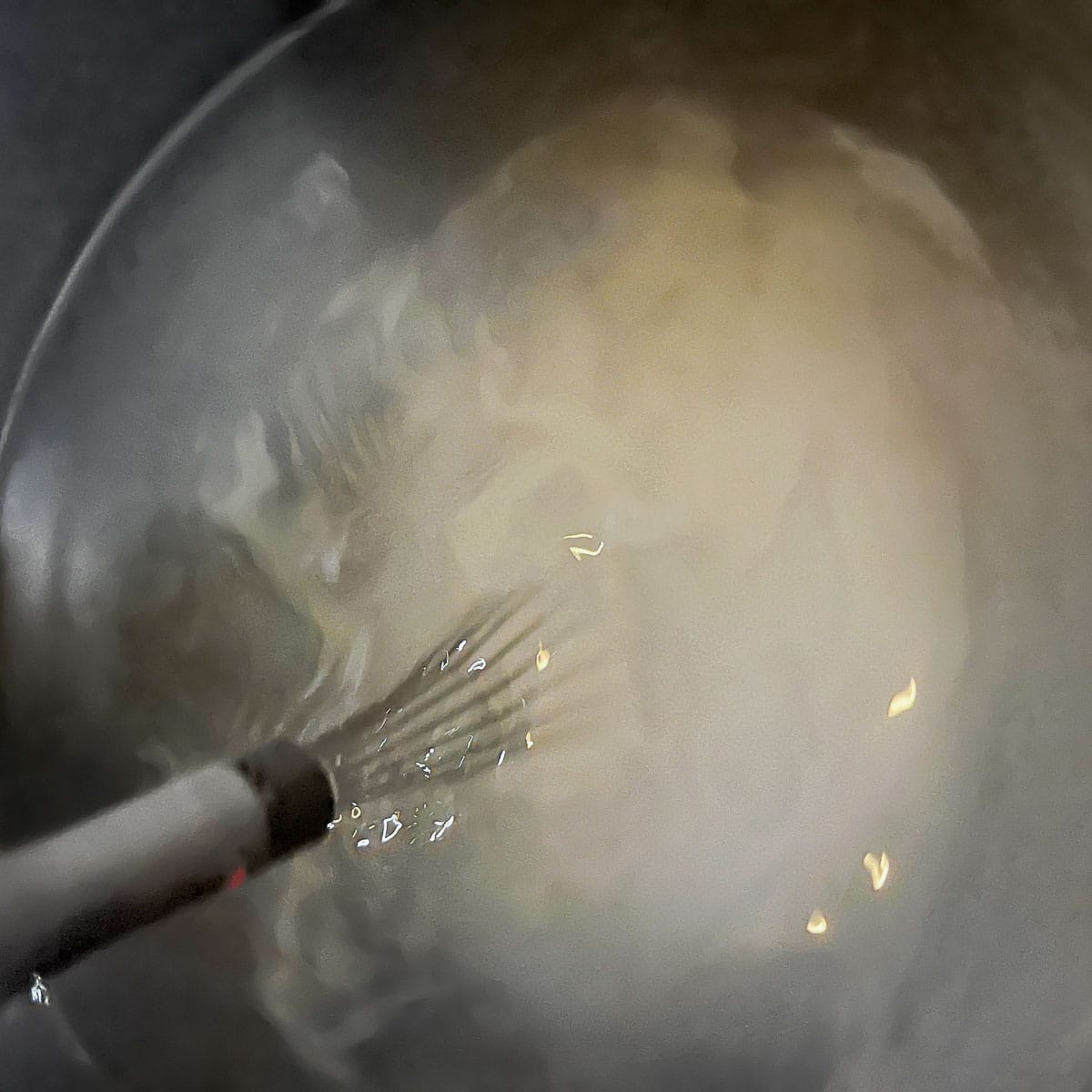
Step 4: Once cool, add pomegranate syrup, acid blend, tannin, and pectic enzyme. Crush campden tablet between two spoons and stir into the wine must (unfermented fruit juice before its converted into wine). Finally, take an SG reading with a hydrometer (optional). Cover the bucket with breathable fabric and use a rubber band to fasten it in place. Set aside for 24 hours.
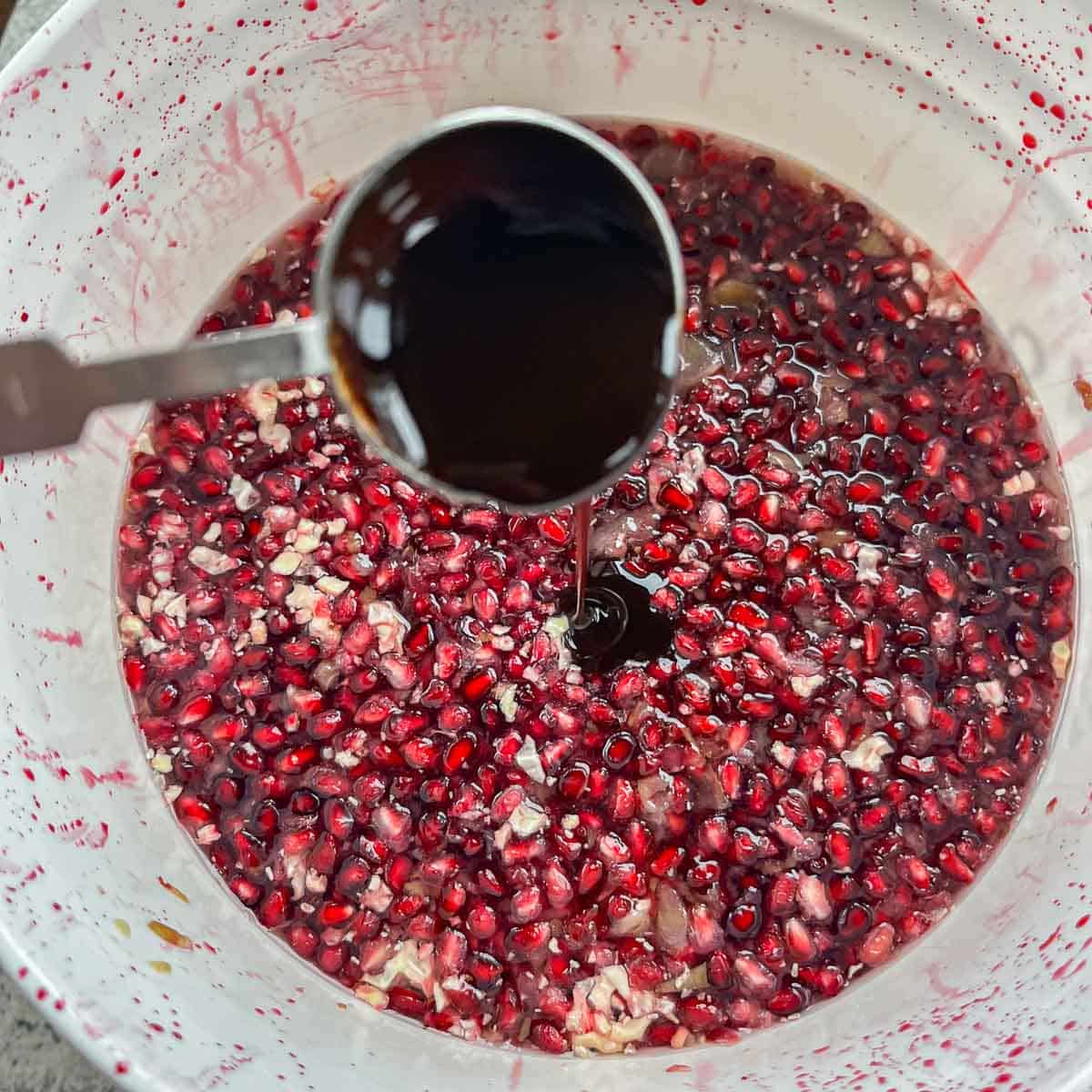
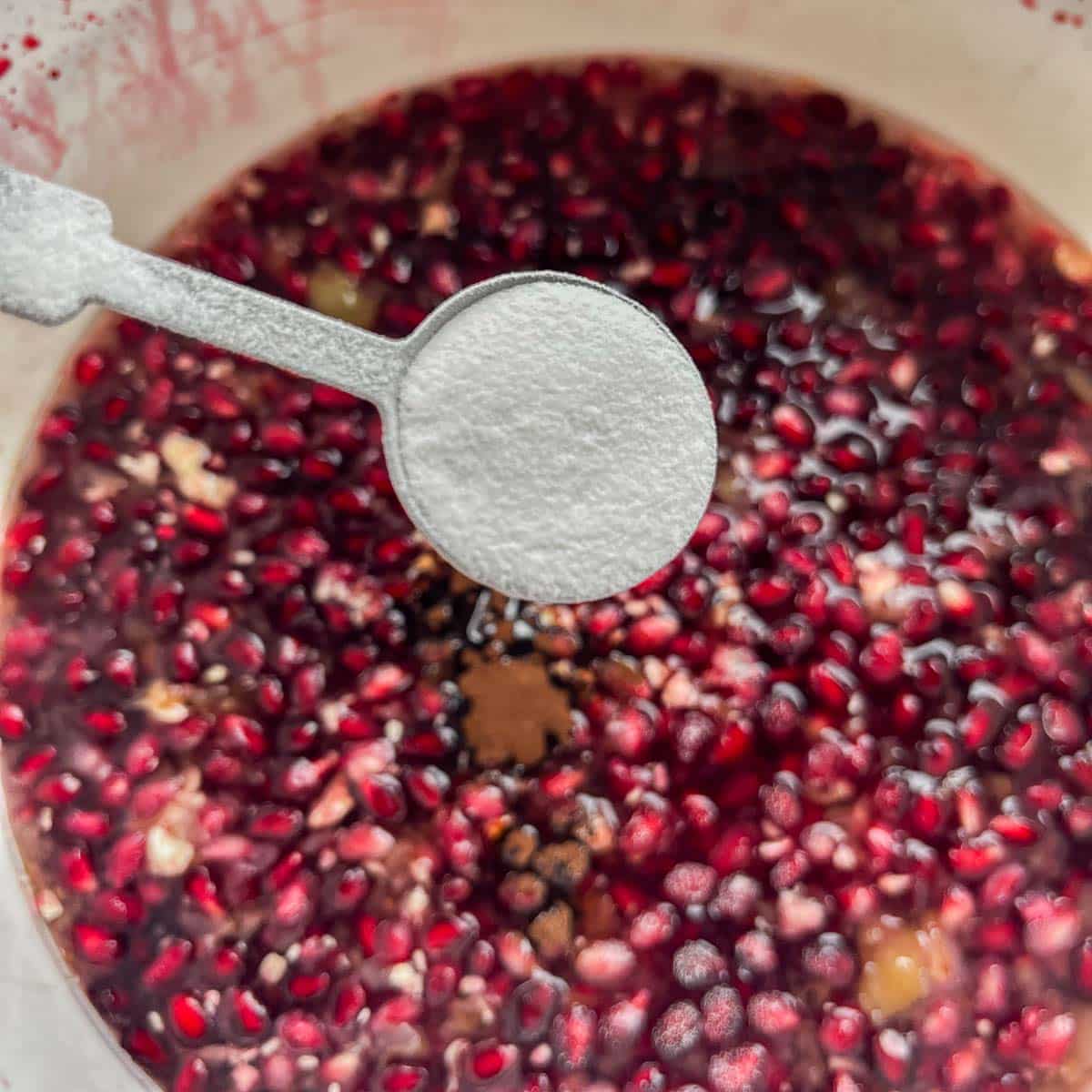
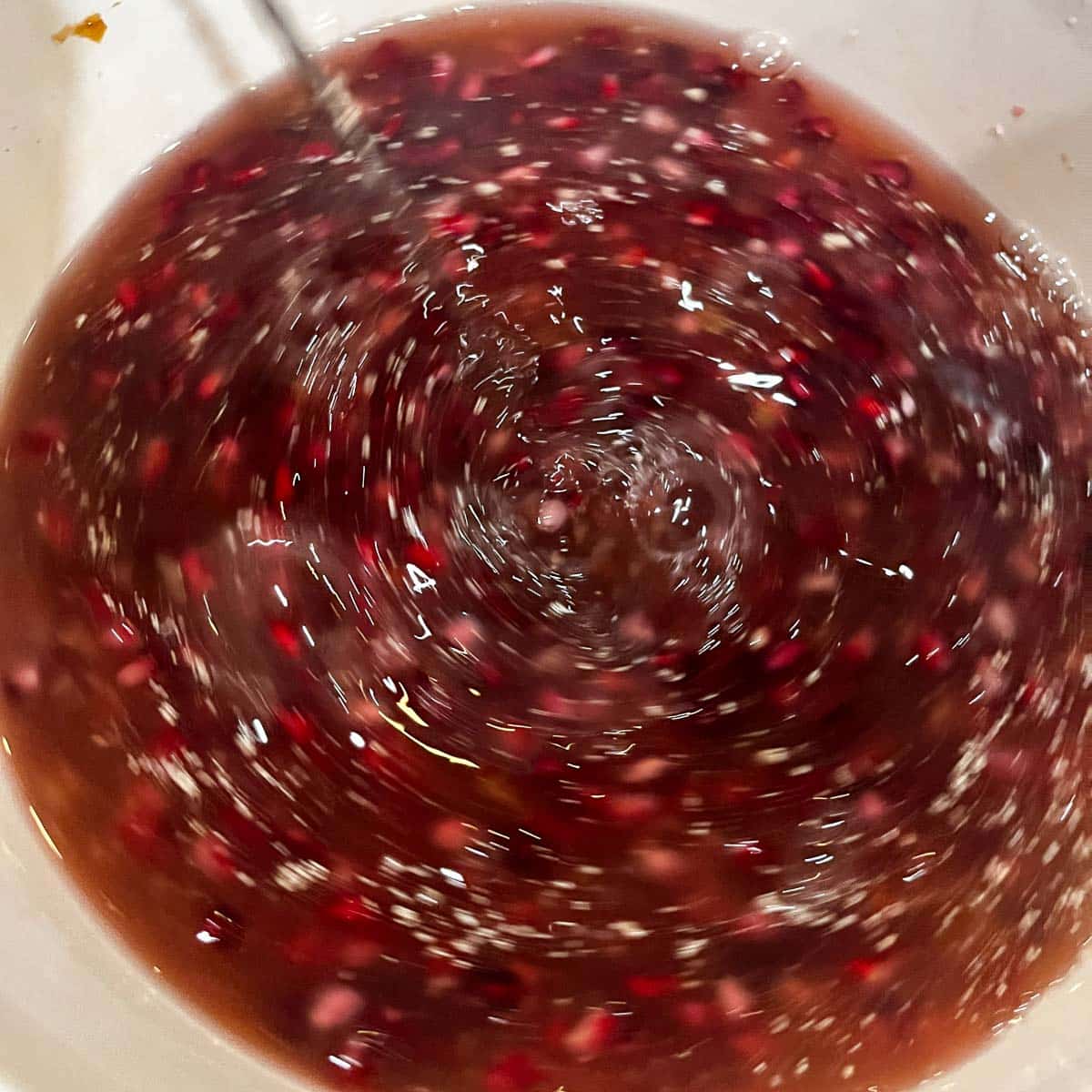
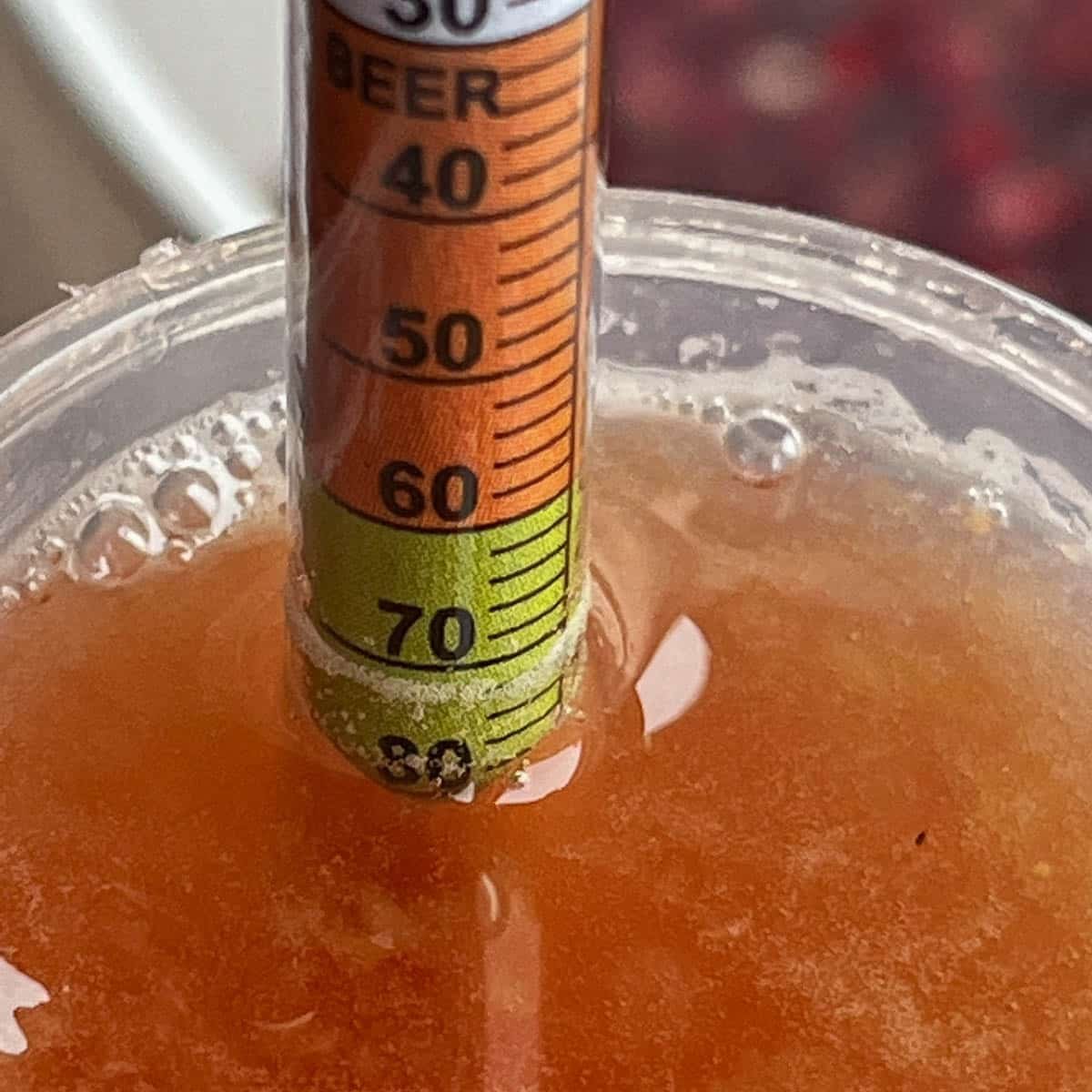
Pro Tip: Taking an SG reading on the first day and at the end, before bottling, will allow you to calculate the ABV (alcohol by volume). This is an optional step.
Would you like to save this recipe?
Day Two
Step 5: Using a sterilized spoon, stir yeast nutrient and ½ of the yeast packet into the must. Cover and set aside.
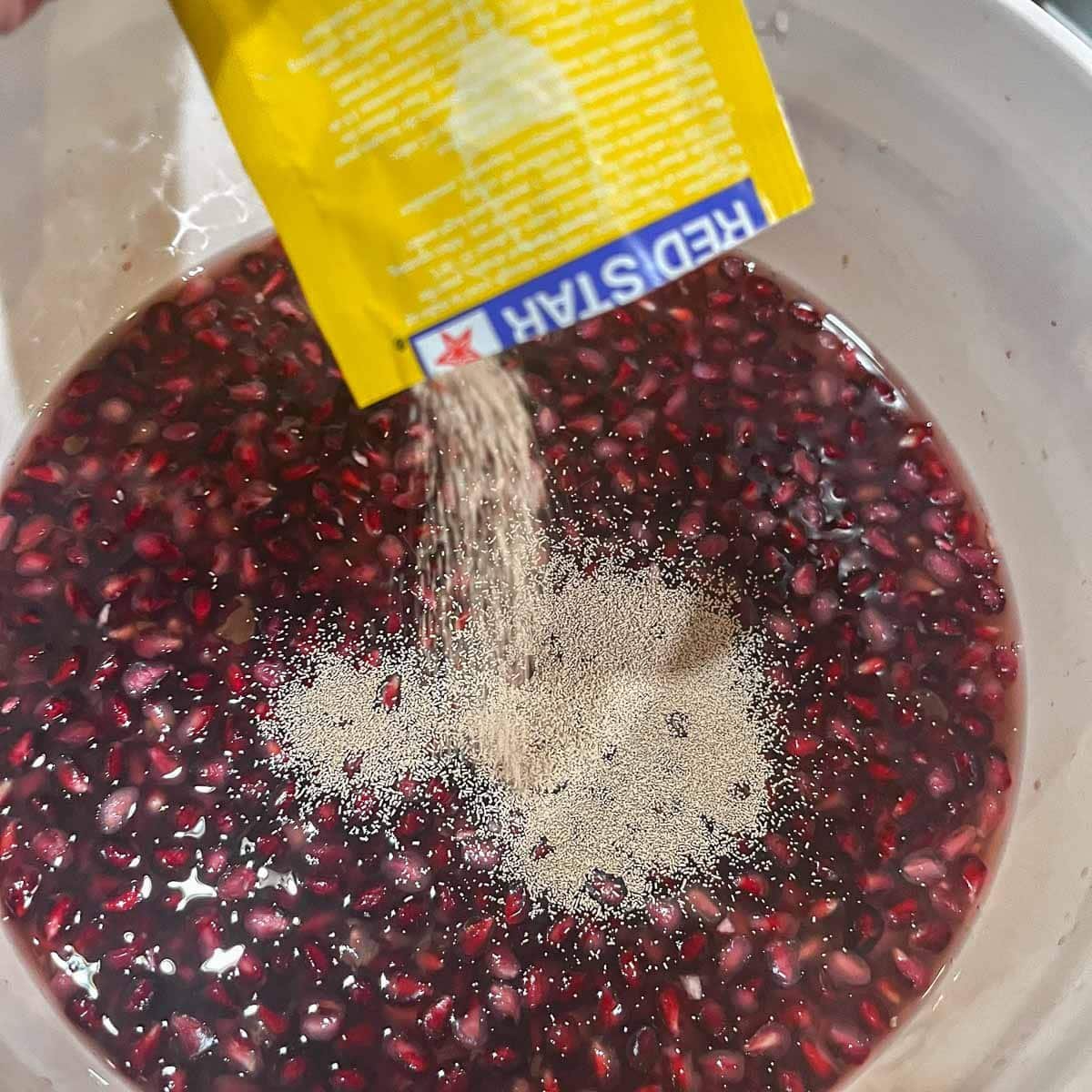
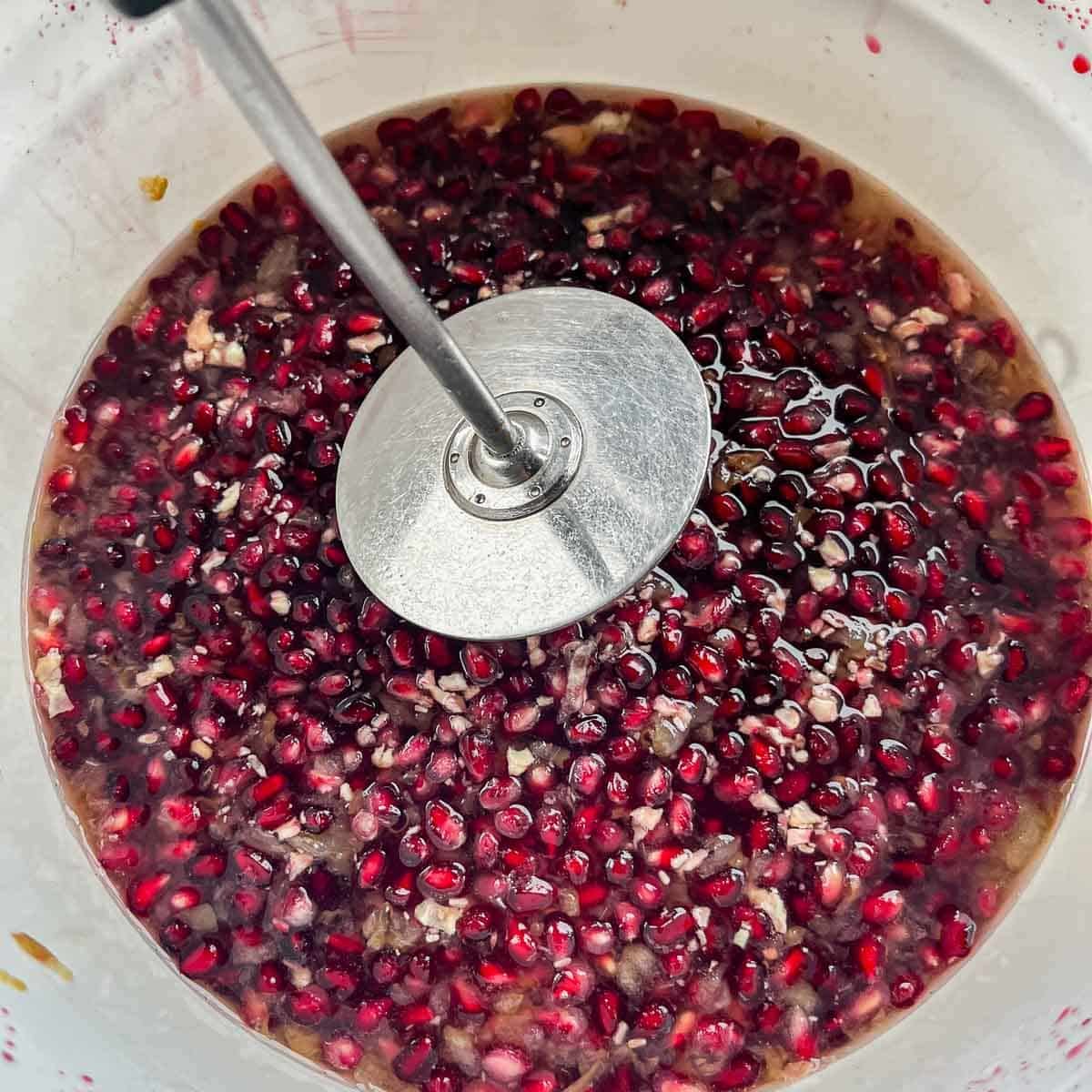
Day 3+
Step 6: Stir daily and take the SG reading. When SG reading reaches 1.030 (day 4—7), remove mesh bag from the fermentor bucket and squeeze the juice back into the bucket, discard seeds or add to compost bin.
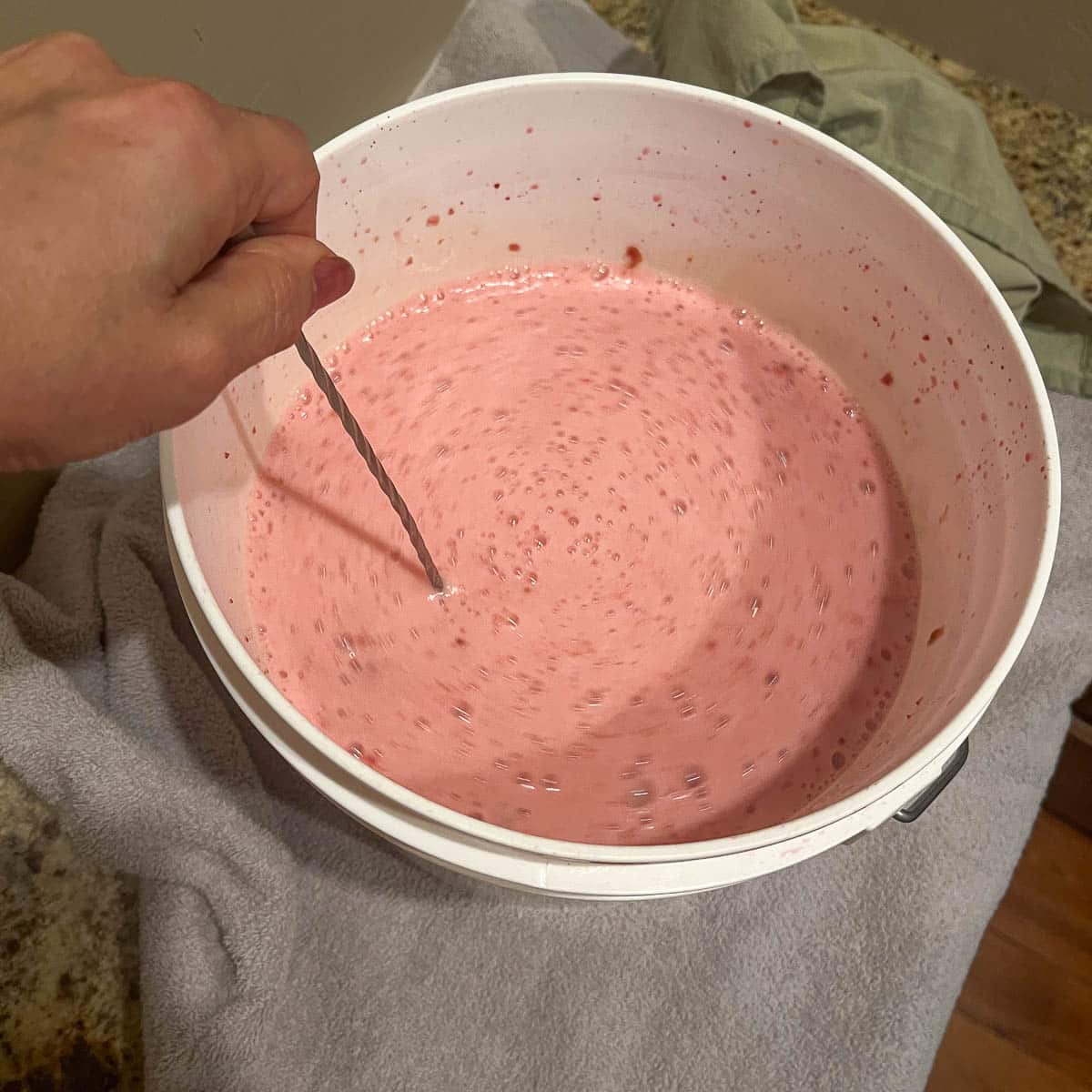

Step 7: Rack (transfer) juice into a one-gallon carboy leaving plenty of space for expansion. Fill airlock halfway with sanitizer solution or water and fit airlock into the bung or screw cap. Store the carboy somewhere away from heat and direct sunlight between 70°F and 85°F.
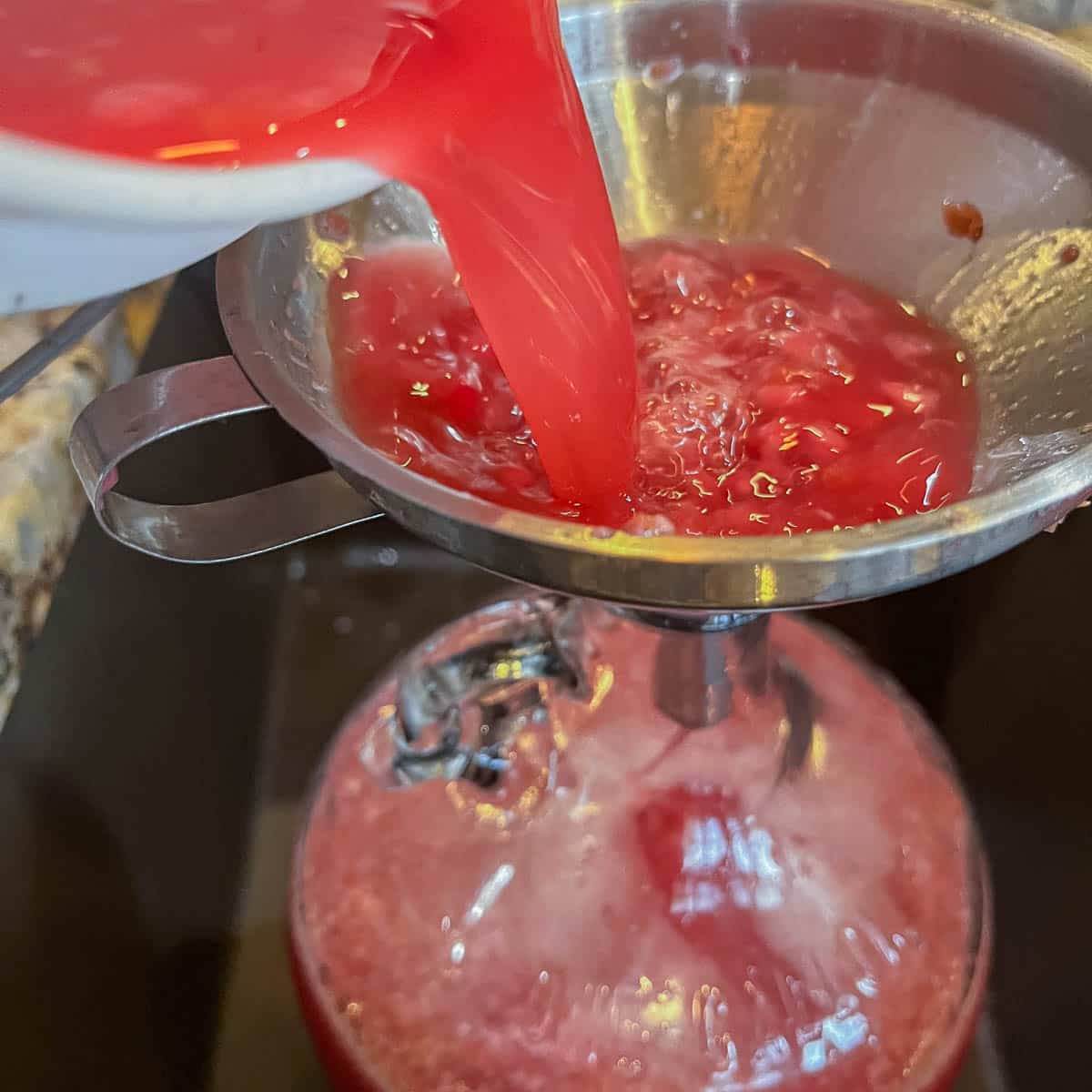
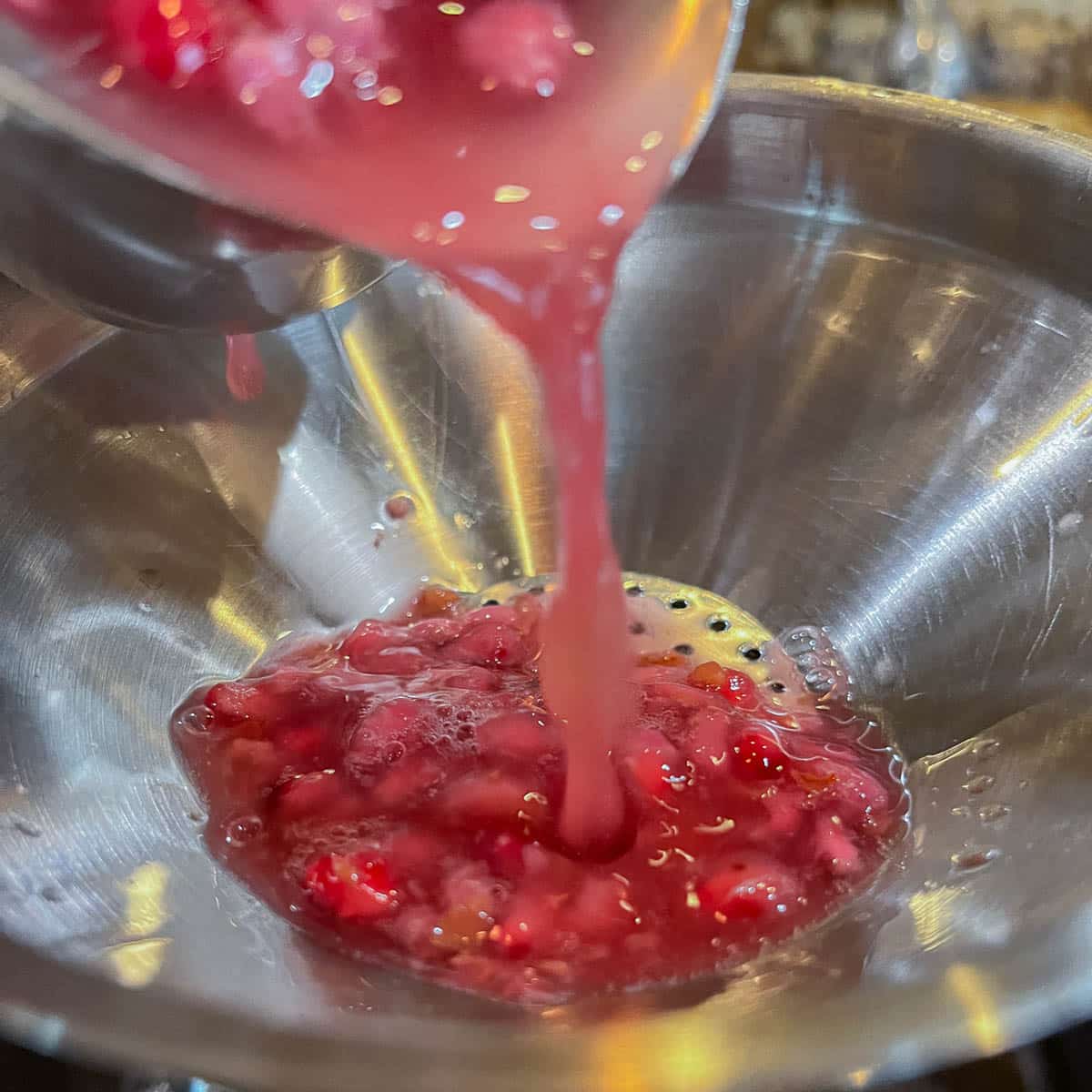

Pro Tip: Pour any extra must in a smaller bottle and top with an airlock.
Step 8: After 3 weeks, the specific gravity should be around 1.000. It's time to transfer the wine into a clean carboy, and leave the sediment behind. Allow the wine to clear anywhere from one to three months, re-racking into a clean carboy each time.
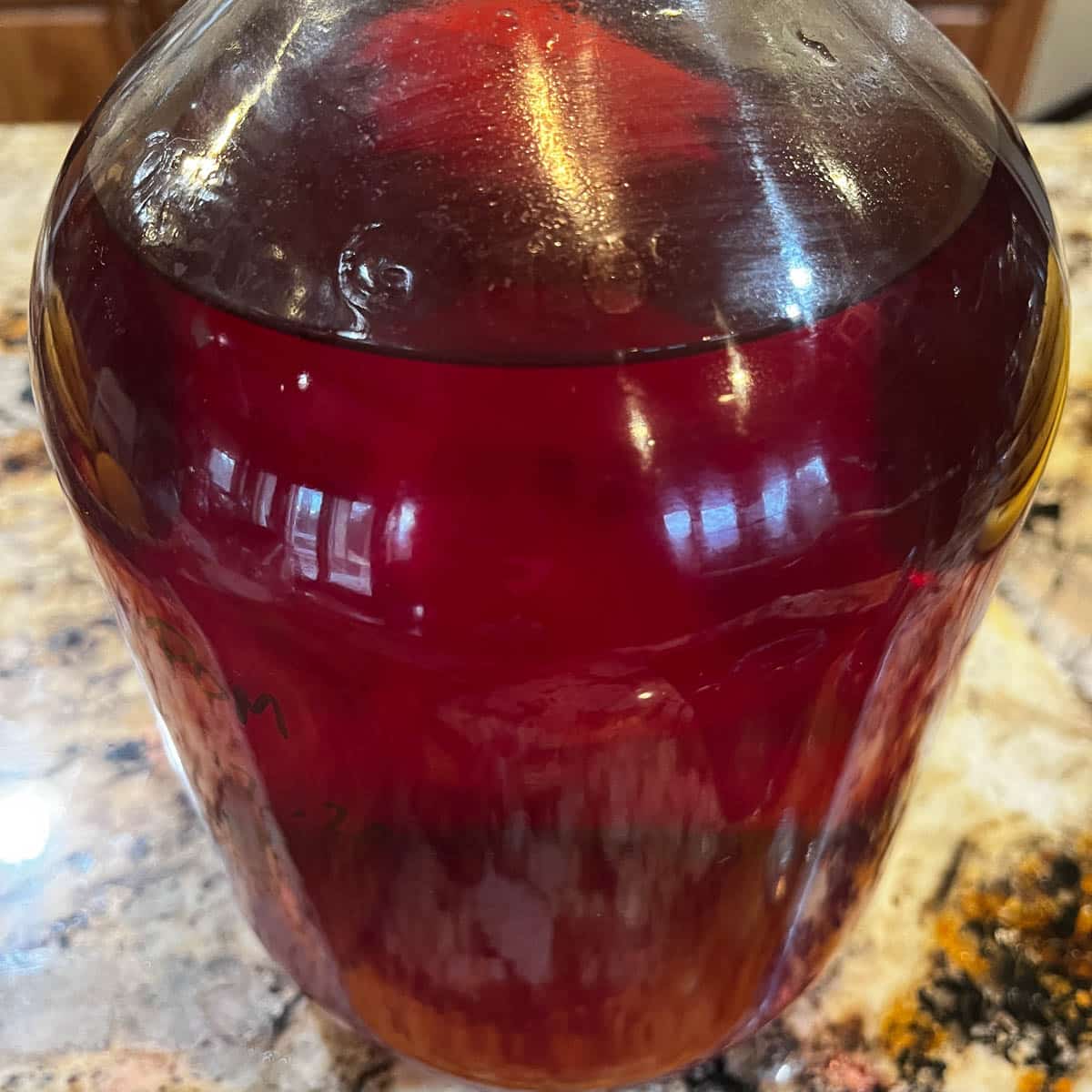
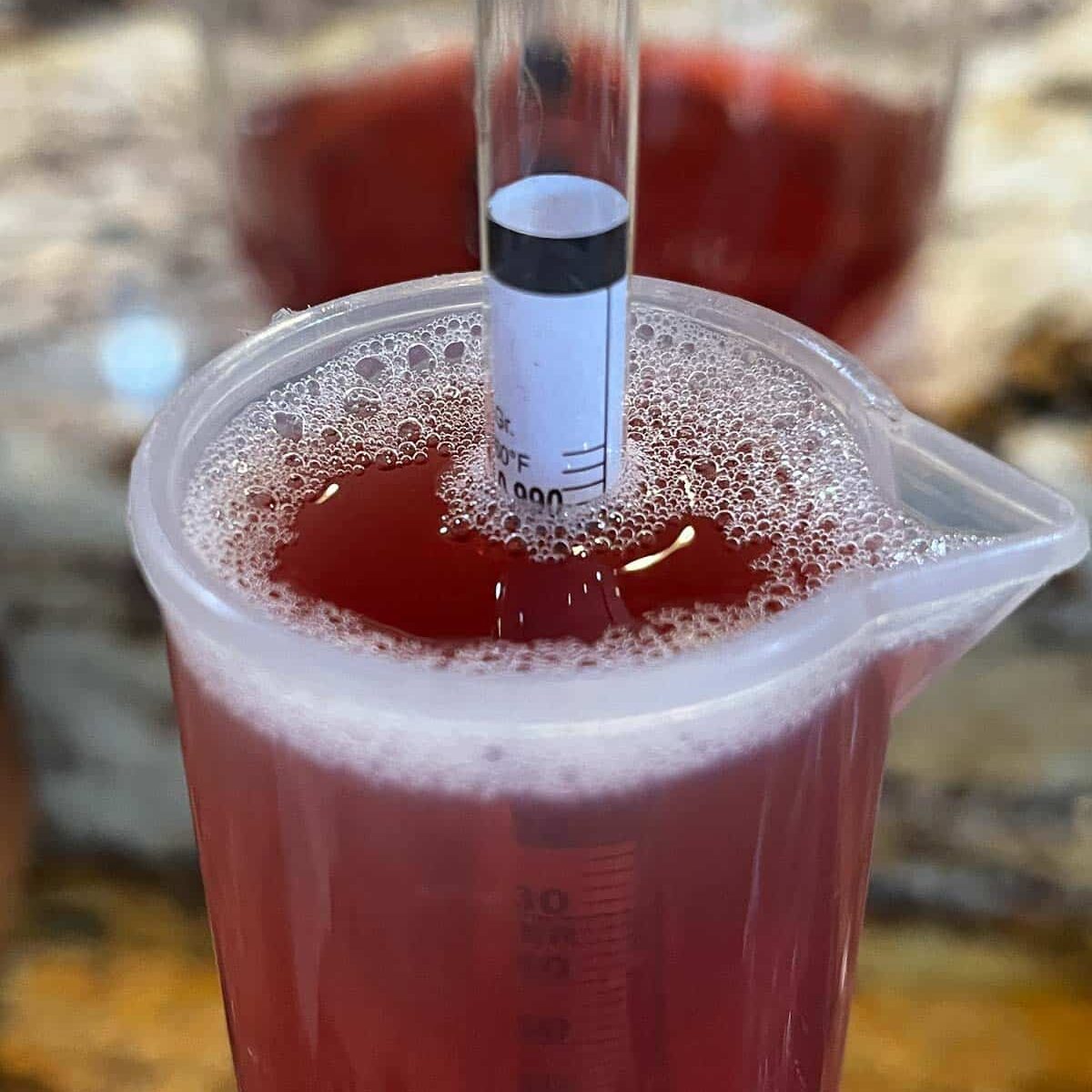
Pro Tip: As you rerack the wine, you end up with less and less wine, because the sediment or lees gets left behind. The extra wine in the smaller bottle can be used to top off the larger jar.
Step 9: Once done clearing, taste the wine to see if it needs sweetening. If you prefer sweet wine, add ¼ to ⅓ cup of simple syrup or pomegranate juice (or to taste) and ½ teaspoon of wine stabilizer to discourage fermentation.

Step 10: Take a final SG reading with your hydrometer and use an ABV (Alcohol By Volume) Calculator to figure out the alcohol percentage. Write the percentage down in a notebook or wine journal. Add one crushed Campden tablet to the wine and stir until dissolved before bottling the wine. Age for at least 6 months then enjoy!
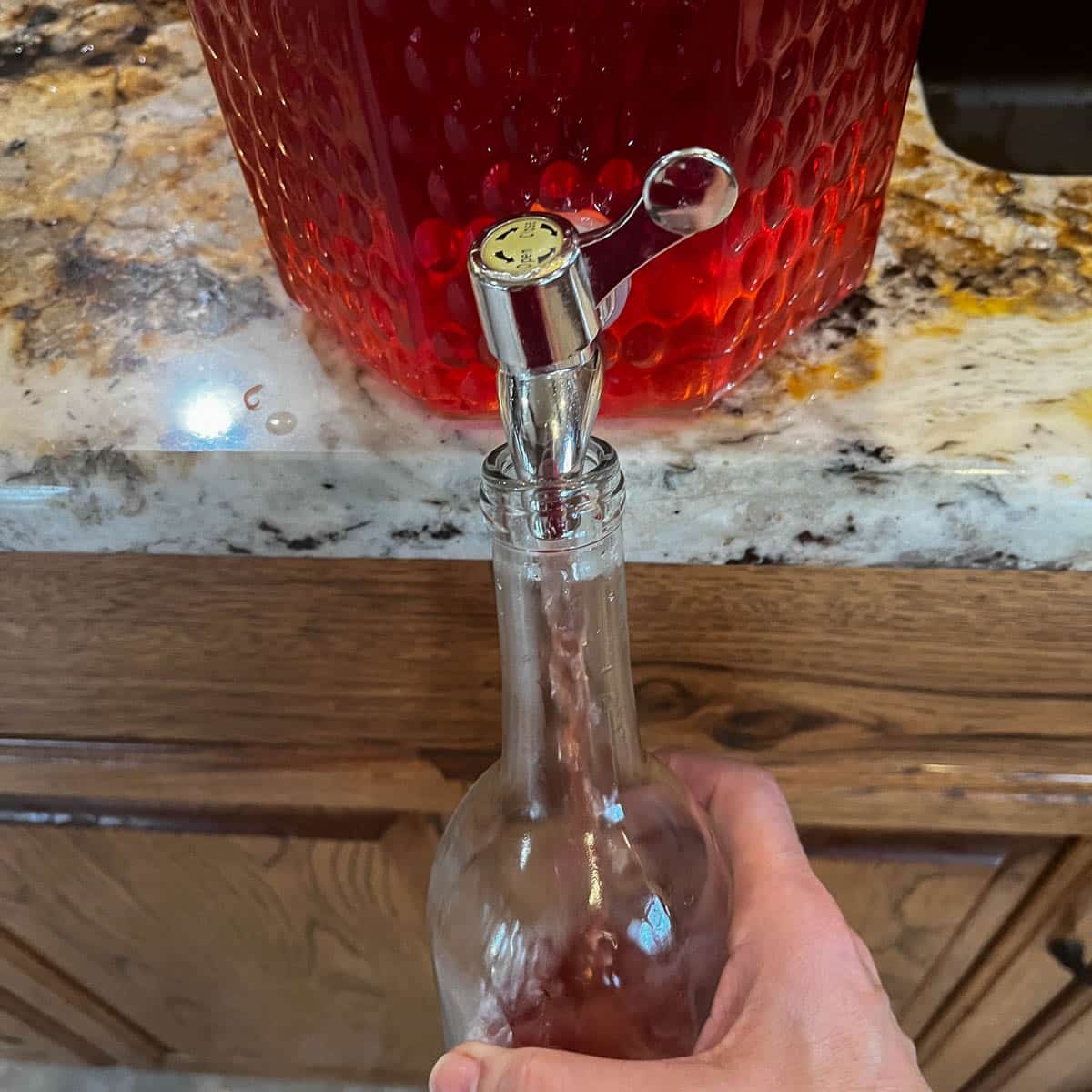
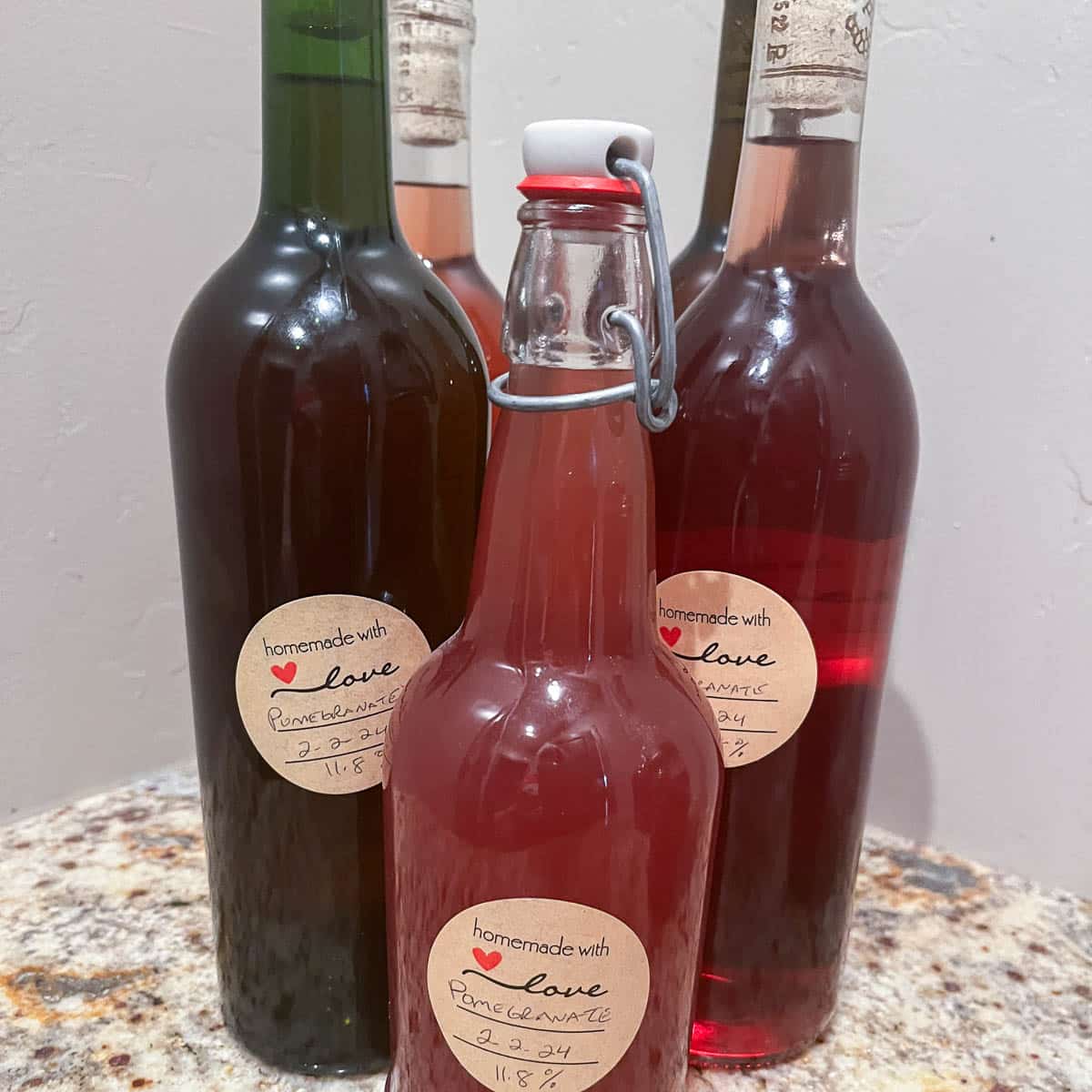
Pro Tip: Once the wine is bottled, label it with the wine type, date, and alcohol %.
🤷🏻♀️ Recipe FAQs
Yes, pomegranates can be used to make a delicious wine with fruity aroma, and a beautiful ruby color.
Pomegranate wine is light, fruity, refreshing, and somewhat sweet. It has a slight lingering tartness, with a finish reminescent of a good rosé. This bright, balanced wine is approachable for self-proclaimed wine lovers and new drinkers alike.
👩🏼🍳 Pro Tips
- When re-racking the wine, add the sediment at the bottom of the carboy to your compost bin, or dilute it with water and use it to water your garden.
- I recommend serving this delicious wine chilled versus at room temperature.
- If you don't want to invest in wine bottles, corks, and a corker, flip-top bottles are a cheaper option.
- When bottling the wine, you may not have enough wine to fill the last bottle. When that happens, just pour it in a flip top bottle and refrigerate until you drink it.
- This is the formula for figuring out the alcohol by volume or ABV: Original gravity reading - final gravity reading x 131.25 = ABV.
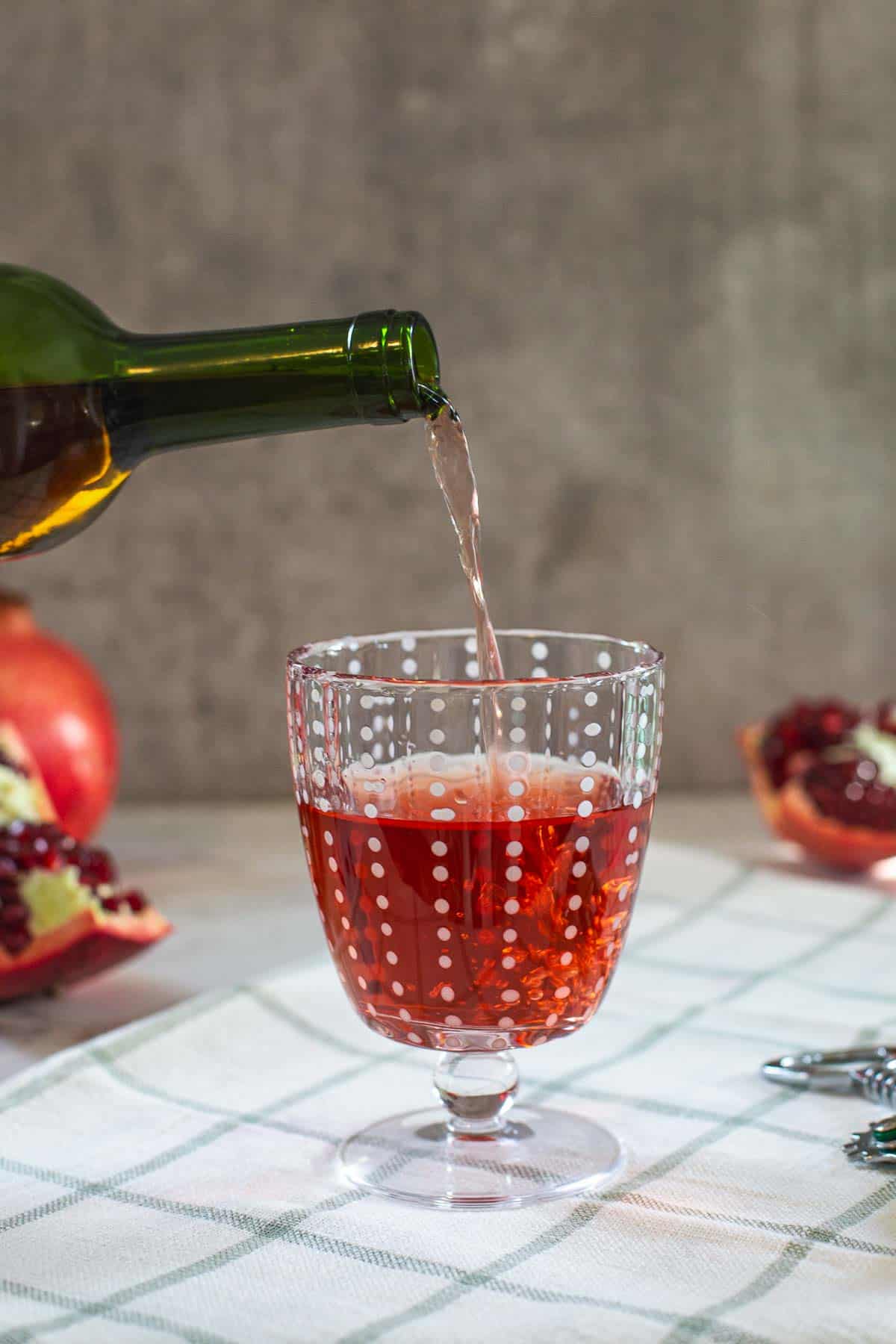
🍾 Related Recipes
If you enjoy this pomegranate wine recipe, you may be interested in these other recipes too!
📖 Recipe
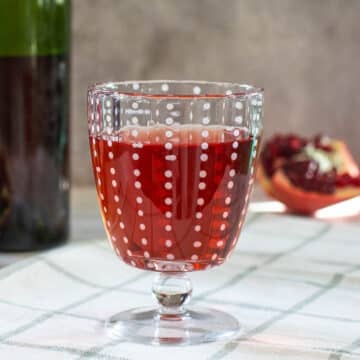
Homemade Pomegranate Wine
Ingredients
- 6-8 large pomegranates (5 cups)
- 1 gallon water
- 2 cups white grapes
- 4 cups granulated sugar (2 lbs)
- 2 tablespoon pomegranate molasses
- 2 teaspoon acid blend
- 1 teaspoon pectic enzyme
- ¼ teaspoon tannin
- 2 campden crush (divided)
- ½ packet wine yeast (premiere blanc)
- 1½ teaspoon yeast nutrient
Instructions
Day 1
- Before you start, you need to sanitize all of your equipment, your work area, and your hands. You can find out how here.
- Wash and peel pomegranates by removing both the peel and membranes between the aril (seeds). Mash the fruit using a potato masher or better yet, a ricer, to release the fruit juice. Do this over your fermenting bucket to catch every ounce of pomegranate juice.
- Blend grapes in a food processor to extract their juice then add to the bucket.
- Add sugar to a stock pot and cover with one gallon of water. Whisk sugar and water and simmer over low heat until sugar is dissolved and the syrup is hot, but not boiling. Pour sugar water over the mashed fruit.
- Once cool, add pomegranate syrup, acid blend, tannin, and pectic enzyme. Crush campden tablet between two spoons and stir into the wine must (unfermented fruit juice before its converted into wine). Finally, take an SG reading with a hydrometer (optional). Cover the bucket with breathable fabric and use a rubber band to fasten it in place. Set aside for 24 hours.
Day 2
- Using a sterilized spoon, stir yeast nutrient and ½ of the yeast packet into the must. Cover and set aside.
Day 3+
- Stir daily and take the SG reading. When SG reading reaches 1.030 (day 4—7), remove mesh bag from the fermentor bucket and squeeze the juice back into the bucket, discard seeds or add to compost bin.
- Rack (transfer) juice into a one-gallon carboy leaving plenty of space for expansion. Fill airlock halfway with sanitizer solution or water and fit airlock into the bung or screw cap. Store the carboy somewhere away from heat and direct sunlight between 70 °F and 85 °F.
- After 3 weeks, the specific gravity should be around 1.000, which means you can transfer the wine into a clean carboy, and leave the sediment behind. Allow the wine to clear anywhere from one to three months, re-racking into a clean carboy each time.
- Once done clearing, taste the wine to see if it needs sweetening. If you prefer sweet wine, add ¼ to ⅓ cup of simple syrup or pomegranate juice (or to taste) and ½ teaspoon of wine stabilizer to discourage fermentation.
- Take a final SG reading with your hydrometer and use an ABV (Alcohol By Volume) Calculator to figure out the alcohol percentage. Write the percentage down in a notebook or wine journal. Add one crushed Campden tablet to the wine and stir until dissolved before bottling the wine. Age for at least 6 months then enjoy!
Notes
- Taking an SG reading on the first day and at the end, before bottling, will allow you to calculate the ABV (alcohol by volume). This is an optional step.
- Pour any extra must in a smaller bottle and top with an airlock.
- As you rerack the wine, you end up with less and less wine, because the sediment or lees gets left behind. The extra wine in the smaller bottle can be used to top off the larger jar.
- Once wine is bottled, label it with the wine type, date, and alcohol %.
- When re-racking the wine, add the sediment at the bottom of the carboy to your compost bin, or dilute it with water and use it to water your garden.
- I recommend serving this delicious wine chilled versus at room temperature.
- If you don't want to invest in wine bottles, corks, and a corker, flip-top bottles are a cheaper option.
- When bottling the wine, you may not have enough wine to fill the last bottle. When that happens, just pour it in a flip top bottle and refrigerate until you drink it.
- This is the formula for figuring out the alcohol by volume or ABV: Original gravity reading - final gravity reading x 131.25 = ABV.

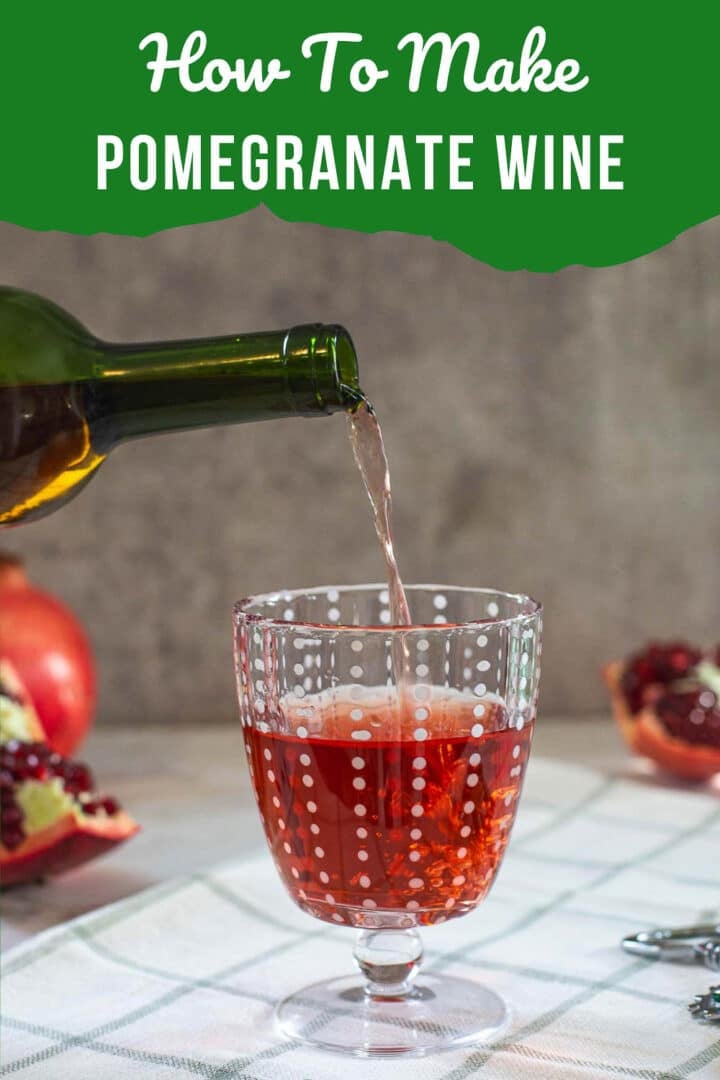

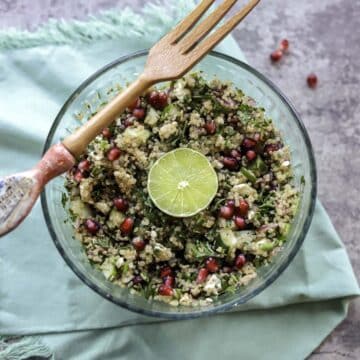







Kelly Methey says
Yummy!!!!!
Hilda Sterner says
Thanks! Nena highly approves!